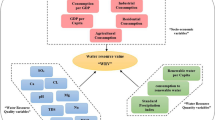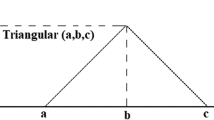Abstract
It has been a consensus that water resources are unevenly distributed in space, often resulting in imbalance between water demand and supply. Quantitative characterization of this inequality of water resources in a region can help prioritize water management by identifying marginalized regions with comprehensive considerations. A framework for evaluating spatial equilibrium of water resources has been proposed by coupling variable fuzzy sets and Gini coefficient methods in this study. The framework was then demonstrated by its application to the Yangtze River Economic Belt (YEB) in China to analyze the dynamics of the spatial equilibrium of its water resources from 2009 to 2018 using three indicators, namely, water resources load index, water and soil matching coefficient and water use benefit. The results show that the spatial equilibrium state of water resources in the YEB is stable in a critical state throughout the period of study, with slight fluctuations. The inequality of water resources load is the main disturbance factor, providing the water management priority toward a better balance between water resources utilization and demand.





Similar content being viewed by others
REFERENCES
Atkinson, A.B., On the measurement of inequality, J. Economic Theory, 1970, vol. 2, no. 3, pp. 244–263.
Barr, N., The Economics of the Welfare State, Stanford, USA: Stanford Univ. Press, 1987.
Bosi, S. and Seegmuller, T., Optimal cycles and social inequality: What do we learn from the Gini index? Res. Economics, 2006, vol. 60, no. 1, pp. 35–46.
Cao, W., Regional ecological equity and its influencing factors, Statistics Decision, 2019, vol. 35, no. 07, pp. 105–108.
Carlos, M.M. and Mark, G.S., Water resources assessment: A spatial equilibrium approach, Water Resour. Res., 1988, vol. 24, no. 6, pp. 793–801.
Chen, S.Y., Theory and model of engineering variable fuzzy set—Mathematical basis for fuzzy hydrology and water resources, J. Dalian Univ. Technol., 2005, vol. 45, no. 02, pp. 308–312.
Chen, S.Y., Variable sets and the theorem and method of optimal decision making for water resource system, J. Hydraul. Eng., 2012, vol. 43, no. 09, pp. 1066–1074.
Gunasekara, N.K., Kazama, S., Yamazaki, D., and Oki, T., Water conflict risk due to water resource availability and unequal distribution, Water Resour. Manage., 2014, vol. 28, no. 1, pp. 169–184.
He, G., Chai, J., Qin, Y., Xu, Z., and Li, S., Coupled model of variable fuzzy sets and the analytic hierarchy process and its application to the social and environmental impact evaluation of dam breaks, Water Resour. Manage., 2020, vol. 34, no. 9, pp. 2677–2697.
Jin, J., Li, J., Wu, C., He, J., Guo, X., Zhang, H., Chen, M., and Chen, L., Research progress on spatial equilibrium of water resources, J. North China Univ. Water Resour. Electric Power (Natural Sci. Edition), 2019, vol. 40, no. 06, pp. 47–60.
Kakwani, N.C., Applications of Lorenz curves in economic-analysis, Ecomometrica, 1977, vol. 45, no. 3, pp. 719–727.
Murray, A.T., Gober, P., Anselin, L., Rey, S.J., Sampson, D., Padegimas, P.D., and Liu, Y., Spatial optimization models for water supply allocation, Water Resour. Manage., 2012, vol. 26, no. 8, pp. 2243–2257.
Shu, H. and Xiong, P., The construction of a mixed environment Gini coefficient and its application in the evaluation of industrial economic and ecological spatial equilibrium, Math. Practice Theory, 2018, vol. 48, no. 13, pp. 9–17.
Wang, Y., Zuo, Q., Liu, H., and Shi, S., Equilibrium analysis of the matching characteristics of water and soil resources in Henan Province, Yellow River, 2018, vol. 40, no. 04, pp. 55–59.
Xia, F., Chen, Y., Dou, M., and Han, Y., Calculation method and application of spatial equilibrium coefficient of water resources, Water Resour. Prot., 2020, vol. 36, no. 01, pp. 52–57.
Yan, F., Liu, L., Zhang, Y., Chen, M., and Chen, N., The research of dynamic variable fuzzy set assessment model in water quality evaluation, Water Resour. Manage., 2016, vol. 30, no. 1, pp. 63–78.
Yang, Y., Gong, S., Wang, H., Zhao, Z., and Yang, B., New model for water resources spatial equilibrium evaluation and its application, Advances Water Sci., 2021, vol. 32, no. 01, pp. 33–44.
Zhang, J., A convenient method to calculate Gini coefficient, J. Shanxi Agricultural Univ. (Social Sci. Ed.), 2007, vol. 6, no. 3, pp. 275–278.
Funding
This research was supported by the National Natural Science Foundation of China (Grant no. 51879010), the National Key Research and Development Program of China (2018YFC0407900 and 2019YFC0408902), the Graduate Innovation Fund in Beijing Key Laboratory of Urban Hydrological Cycle and Sponge City Technology (HYD2020IFDC03) and the 111 Project (Grant no. B18006).
Author information
Authors and Affiliations
Contributions
Yafeng Yang: Conceptualization, Methodology, Validation, Data curation, Data interpretation, Drafting manuscript. Hongrui Wang: Supervision, Resources, Funding acquisition. Cheng Wang: Conceptualization, Methodology, Drafting manuscript. Yuanyuan Zhang: Methodology, Software, Calculation and results analysis, Validation.
Corresponding author
Ethics declarations
The manuscript has not been published elsewhere, and it has not been submitted simultaneously for publication elsewhere. We also have no conflicts of interest to disclose. All authors have seen and approved the manuscript and have contributed significantly to the paper. The authors declare no conflict of interest.
Rights and permissions
About this article
Cite this article
Yang, Y., Wang, H., Wang, C. et al. Coupling Variable Fuzzy Sets and Gini Coefficient to Evaluate the Spatial Equilibrium of Water Resources. Water Resour 49, 292–300 (2022). https://doi.org/10.1134/S0097807822020154
Received:
Revised:
Accepted:
Published:
Issue Date:
DOI: https://doi.org/10.1134/S0097807822020154




